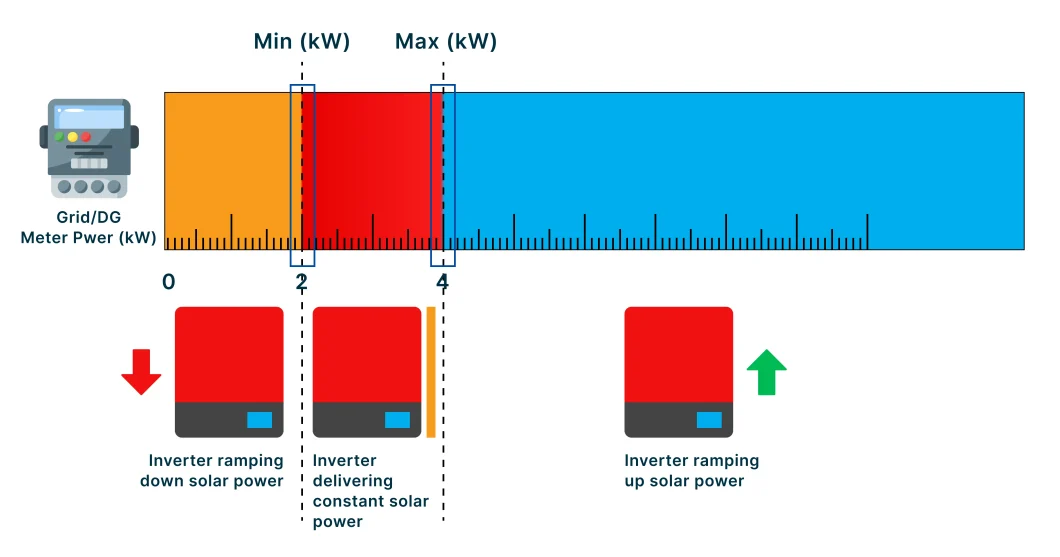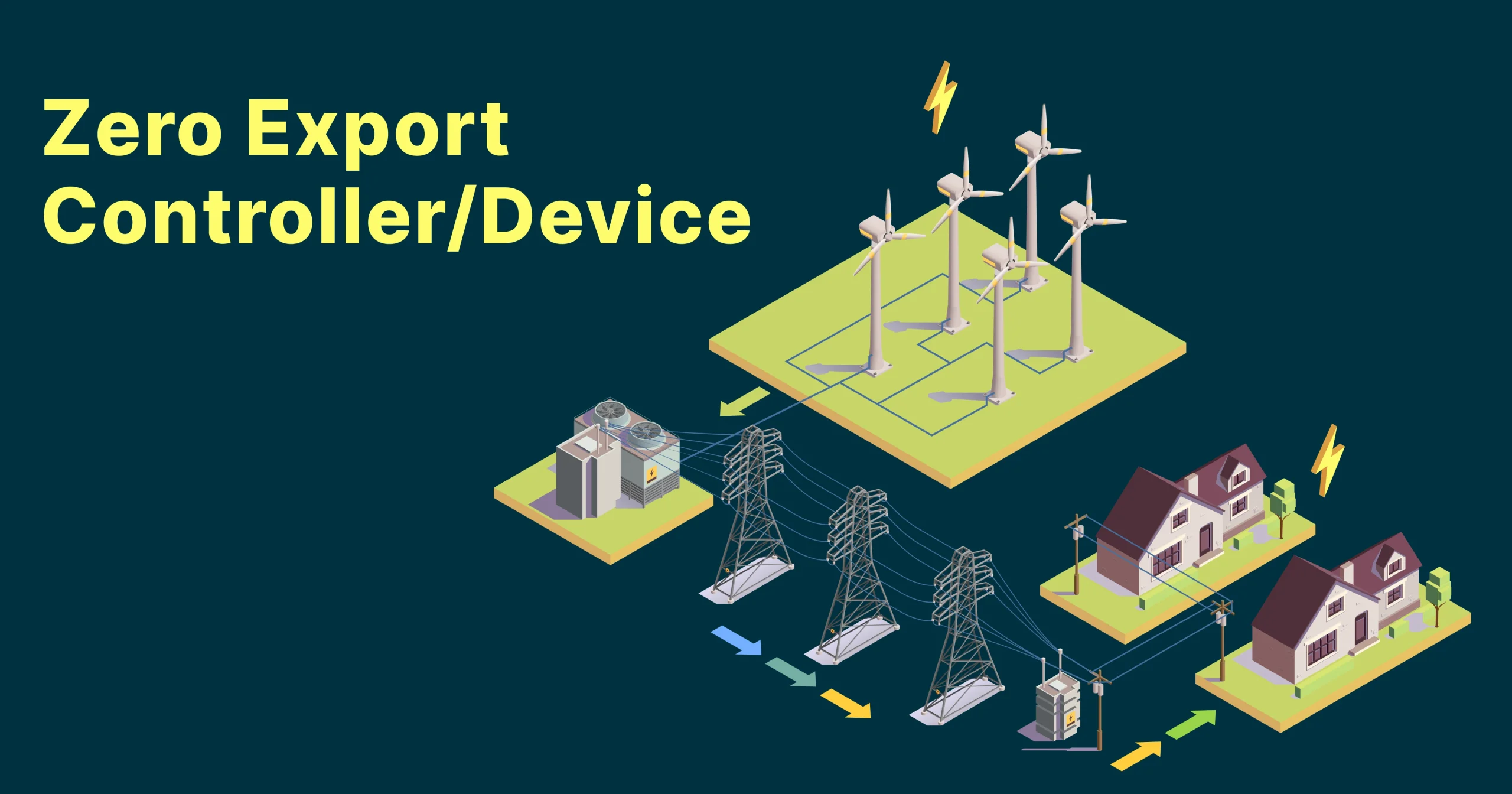The Power Control Device (PCD) employs an algorithm to guarantee flawless operation of power control, even during rapid load fluctuations. The device ensures that the inverter promptly adjusts its output at a suitable rate preventing any reverse feed into the grid or DG. This ensures that solar power is generated at the optimal and required rate.
Table of Contents
- What is a Zero Export Controller/ Device?
- Functional Description
- Working Principle
- How is the Configuration of the Zero Export Device (ZED) Power Control Done?
- Sample Case for Zero Export Device Use Case
- Key Features of Zero Export Device
- Representation of the 3 Potential Scenarios
- Frequently Asked Questions
What is a Zero Export Controller/ Device?
It simply means “No export power to the Grid”
The zero export controller serves the goal of preventing any surplus power from being returned to the grid. Instead, it directs the generated solar energy towards powering the local load. Voltage and current are closely monitored and restricted based on the load needs. Through efficient energy flow management, the zero export controller ensures that the inverter produces an amount of energy equal to or less than what the load requires.
In specific areas such as India, where net metering is mandatory, obtaining essential approvals and installations from the local DISCOM (distribution company) can lead to a considerable delay of 6-8 months. In these situations, the utilization of a zero export controller proves to be extremely beneficial. This is because installing a one-way meter on-site causes clients to incur unnecessary expenses, as it leads to the production of surplus unused energy. By incorporating a zero export controller, clients can prevent these extra expenses by ensuring that no surplus energy is transmitted back to the grid.
Functional Description
As regulations on export control for residential and medium-sized commercial PV systems become more stringent, the zero export controller emerges as the ideal solution!
Export limitation refers to the regulation of solar energy within the system by adjusting the set point of the inverters. The integrated power analyzer assesses the overall power at the coupling point and compares it to the controller’s adjustable set point. When the grid consumption exceeds the specified threshold, the input of solar energy is increased. Conversely, if the consumption drops below the set point, the input of solar energy is reduced.
The zero export controller is offered in both single and three-phase configurations, accommodating up to ten diverse types of inverters and manufacturers. This all-in-one device seamlessly integrates a power analyzer, data logger, and controller. Zero export controller has innovatively combined these three functionalities into a single component, ushering in a new era of comprehensive solutions. The zero export ensures that, at all times, the solar system is prevented from exporting power to the grid.
Read About: IoT For Electric Vehicle Monitoring & Management
This significantly minimizes the expenses associated with the system and the required space. The real-time control facilitated by a user-friendly web interface offers graphical representations of both current and past grid and solar power consumption. The controller stores this data on a USB device for subsequent analysis. Through the implementation of intelligent load switching with customizable thresholds, the system aims to optimize self-consumption.
Each system possesses unique layouts and specifications. With a user-friendly web-based interface and a step-by-step installation guide, commissioning will require no more than 5 minutes of your valuable time. The user-friendly settings make it simple to configure zero export according to the specific needs or requirements of your system.
The zero export controller is compatible with a diverse range of inverter manufacturers such as SMA, KACO, ABB, REFUsol, Fronius, GROWATT, ZEVER SOLAR, DELTA, SOFAR SOLAR, HUAWEI and many others. Feel free to inquire about additional inverters as the list of supported inverters continues to expand regularly!
Working Principle
Export limitation involves reducing the surplus power from a photovoltaic (PV) system that is supplied to the grid. Zero feed-in implies that no extra PV power is sent to the grid.
Export to the grid = Produced solar energy > Consumption from the grid

How is the Configuration of the Zero Export Device (ZED) Power Control Done?
The system’s operations are configured through its web interface minimizing the need for physical presence on-site. To establish power control within the device, a reference range is defined based on minimum and maximum power readings at the Bi-directional meter. This meter measures incoming grid power in the absence of export and DG output power during DG Sync. The lower limit of this range is denoted as Min(kW) while the upper limit is designated as Max(kW).
Currently, we categorize the power control mechanism into three stages.

Sample Case for Zero Export Device Use Case
Imagine a solar plant with a capacity of 10 kWp and a maximum load of 15 kWp. Let’s establish the minimum set point at 0.5 kWp and the maximum set point at 1 kWp. In a scenario where the required load is 7 kWp and the solar output is 8 kWp, the ZED will instruct the solar system to reduce power production to meet the 7 kWp demand. Conversely, if the load increases to 11 kWp while the solar system is generating 8 kWp, the ZED will allow the solar system to operate at its full capacity, with the additional power needed to be sourced from the grid, totaling 3 kWp.
If the grid input power falls within the specified minimum and maximum set points while reducing the solar system’s power output, the ZED will cease instructing the solar system to adjust its power output.
Key Features of Zero Export Device
1. Smart Control
This key feature ensures the device smartly manages the power output of your solar system to prevent excess energy from being exported to the grid. It constantly monitors energy production & consumption, dynamically adjusting inverter output to match your real-time needs. This optimizes solar power usage and minimizes reliance on the grid.
2. Flawless Protection
This feature provides various safeguarding mechanisms to protect your system & ensure safe operation. It may include features like:
- Anti-islanding protection: Automatically disconnects the solar system from the grid in case of power outages preventing unintended power flow back to the grid.
- Surge protection: Shields your system from harmful voltage spikes that can damage equipment.
- Ground fault protection: Detects & interrupts ground faults preventing potential electrical shock hazards.
3. Graphical Representation
This feature provides clear & easily understandable visuals of your energy data. It may include:
- Real-time power generation & consumption charts: Monitor how much solar energy is being produced & used at any given moment.
- Historical data summaries: Track your energy usage trends over time & identify areas for improvement.
- System performance dashboards: Gain insights into overall system health & efficiency.
4. Remote Monitoring
This feature allows you to access & manage your zero export device remotely typically through a mobile app or web interface. This enables you to:
- View real-time & historical data: Monitor your system’s performance from anywhere, anytime.
- Adjust settings: Change operating parameters like maximum grid import or export limits.
- Receive alerts: Get notified about potential issues or system performance changes.
5. Deemed Generation
This feature, mainly relevant in specific regions like India, allows you to virtually inject solar energy you haven’t exported back into the grid. This can offset grid-purchased electricity & potentially lead to financial benefits depending on local regulations.
- Capable of Active Power Control through Modbus RS-485 or Modbus TCP/IP, it is compatible with a diverse array of inverters.
Logic
Zero Export works on a simple logic as mentioned below:
1. Read Active Power from net meter
2. Is Active power > Max Setpoint? If yes, increase power on inverters
3. Is Active power < Min Setpoint? If yes, decrease power on inverters
4. Repeat from step 1
Minimum set point: This denotes the lowest necessary power input needed from the grid supply.
Maximum set point: It is the highest level of power input needed from the grid supply when there is ample solar power generation to meet the load requirements.
Here is a basic Single Line Diagram (SLD) illustrating the functionality of zero export in a solar PV system. To achieve zero export, it is essential to install a bidirectional net meter on the incoming side. This meter must have MODBUS RTU capability enabling communication with our power control device for reading ACTIVE POWER values.

Representation of the 3 Potential Scenarios
Condition 1: If the output power of the bidirectional meter falls below the specified range.
In this scenario, when the ZED detects that the bidirectional meter reading falls below the specified ‘Minimum’ as per the power control algorithm, it issues a throttle-down command to the ZED. This cycle repeats every 5 seconds until the bidirectional meter reading is within the ‘defined’ range.
Condition 2: When the output power of the bidirectional meter falls within the specified range.
When the ZED detects that the bidirectional meter reading falls within the ‘specified range,’ the control command from the ZED directs the inverter to maintain the current state of generation until the next command is received.
Condition 3: When the output power of the bidirectional meter significantly exceeds the specified range.
In the recent scenario, when the bidirectional meter reading detected by the ZED exceeds the predetermined range, the ZED directs the inverter to operate at its maximum efficiency, specifically 100%.
Dynamic feed-in control
Up until this point, there hasn’t been a convenient and widely applicable solution for managing the input of solar energy into the grid while simultaneously maximizing self-consumption.
HashStudioz introduces the inaugural product that enables dynamic limitation for nearly all currently available inverters on the market.
Utilizing dynamic limitations, as opposed to a fixed limit, for the inverter (e.g., setting it at 70%), can significantly decrease energy consumption from the grid.
When the production exceeds the set limit, the energy from the solar system is diverted without any dynamic restrictions.
The HashStudioz zero export directs power initially towards household consumers such as water heaters or other domestic appliances.
The zero export controller continuously monitors the power flow within the system, dynamically adjusting the set point of the solar system. If energy is being directed toward the grid, the HashStudioz zero export will diminish the output of the solar system. Conversely, when there is a surplus of energy within the system, all solar energy generated is utilized onsite.
HashStudioz introduces the zero export, the initial inverter-independent solution that enables dynamic control of solar energy output from the inverter. This optimization of the entire system leads to a reduction in overall costs.
Thanks to the integrated solution that incorporates a high-resolution power analyzer, data logger and dynamic feed-in controller, controlling dynamic feed-in is now as simple as necessary.

Frequently Asked Questions
1. Is it possible to control and monitor two different inverter brands using the same device?
Certainly. The device can effectively monitor two different inverters, each operating on different protocols namely Modbus RTU and Modbus TCP/IP.
2. Is it possible to ensure no export of energy throughout the day?
Reaching zero exports is not a 100% certainty. Brief instances of power flow into the grid may occur for a few seconds when there are significant changes in the load. However, in general, the system maintains the condition of zero export under normal circumstances.
3. What is the frequency of power control?
Five seconds is the device’s default frequency. The speed of power control depends on the MODBUS communication speed of all inverters. The majority of them respond or act within a few milliseconds resulting in power export occurring within the same time range.

